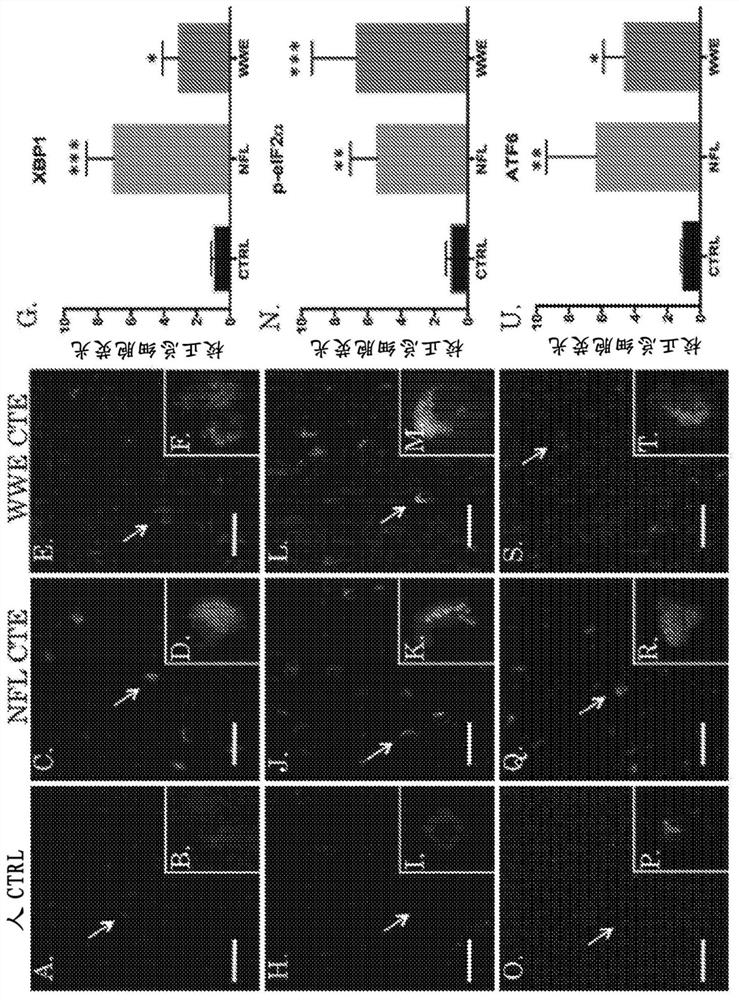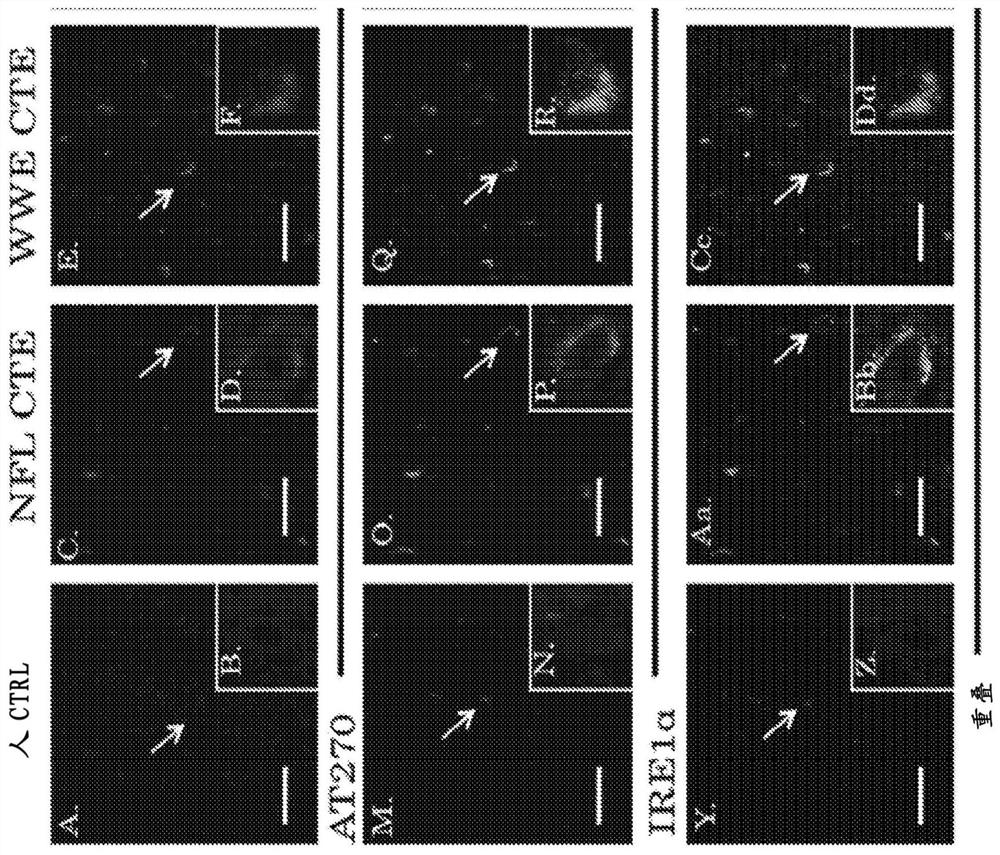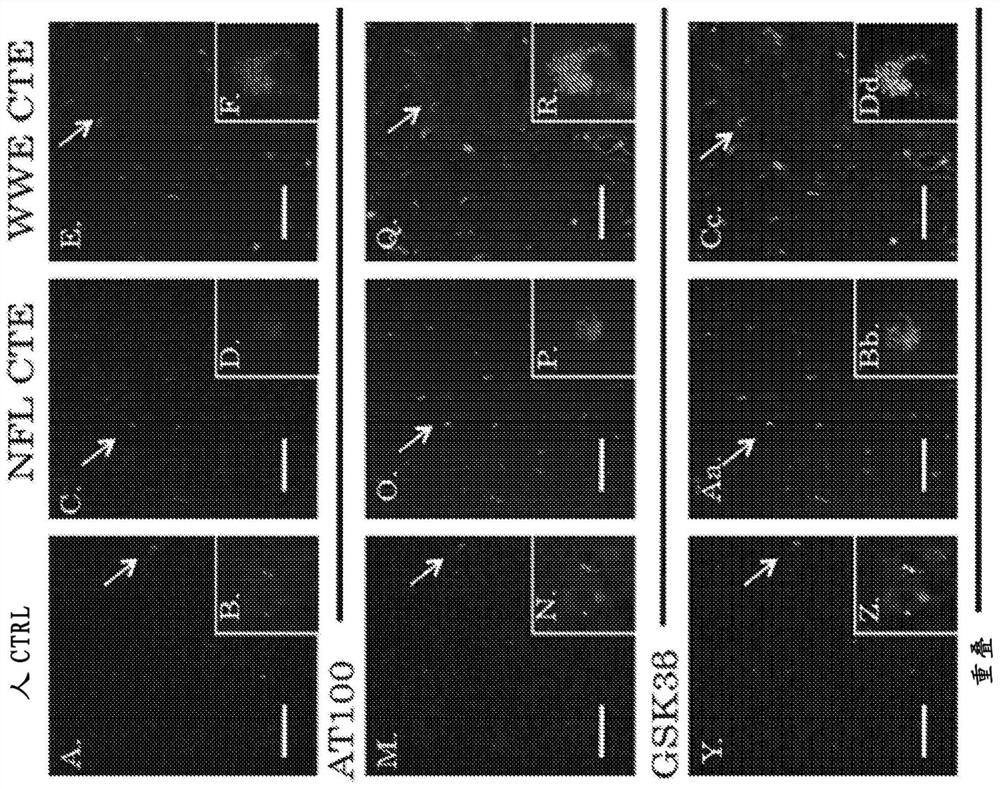Treatment of chronic traumatic encephalopathy
A chronic trauma, traumatic technology, applied in the direction of organic active ingredients, non-central analgesics, medical preparations containing active ingredients, etc., can solve problems such as unclear TBI
- Summary
- Abstract
- Description
- Claims
- Application Information
AI Technical Summary
Problems solved by technology
Method used
Image
Examples
Embodiment 1
[0072] Human brain specimens were collected from the entorhinal cortex of athletes diagnosed with postmortem CTE. Specimens were stained for markers of ER stress alone and also colocalized with markers of tauopathies. Traditional immunohistochemistry was used in combination with primary antibodies specific for ER stress and pathological tau and fluorescent secondary antibodies. Overlapping regions were detected with colocalization software (ie, ImageJ). ANOVA was used to correct for total cytofluorescence analysis. P<0.05 was considered statistically significant. (*=p<0.05, **=p<0.01, and **=p<0.001).
[0073]The results showed that all three branches of the ER stress pathway were increased in human CTE specimens. ER stress was also found to be increased in the same regions where tauopathies were observed, suggesting ER stress during the disease process. This was confirmed by staining for glycogen synthase kinase β, GSK3β (a catalytic tau kinase associated with ER stress)...
Embodiment 2
[0078] This example evaluates the successful targeting of ER stress after TBI. Such as Figure 4 As shown in images A and B, a tabletop air acceleration damage model was developed. Sprague Dawley rats were placed in a protective tube to prevent damage to surrounding organs, and an acceleration wave was generated and collided with the rat's skull. The intensity of the damage was modulated in a stepwise manner by decreasing or increasing the thickness of the membrane exploded with pressurized nitrogen. An injury paradigm of 50 PSI was chosen, which correlates with human concussion, the most common type of injury associated with CTE. exist Figure 4 , the peak in plot D shows a 50 PSI pressure wave. Sprague Dawley rats received one or six injuries over a two-week period. Various time points of sacrifice were chosen to observe markers of ER stress and tauopathies.
[0079] Salubrinal was administered to rats after injury to target ER stress. Salubrinal was administered at a...
Embodiment 3
[0088] In this example, the effect of targeting (turning off) ER stress on improving behavior was investigated by using an injury model and standard protocols for the Morris water maze and the elevated plus maze. The Morris water maze detected deficits in cognitive performance, while the elevated plus maze assessed impulsive-like behavior. The results suggest that targeted ER stress can reduce impulsive-like behavior and improve cognitive performance if delivered after injury. Statistical analysis was performed using ANOVA, where *=p<0.05, **=p<0.01, ****=p<0.001. #=p<0.05, ##=p<0.01, ###=p<0.001 when drug was compared to the injury group.
[0089] Figure 11 Shown are images and plots illustrating that post-injury administration of salubrinal (SAL+bTBI) 7 days after a single injury reduces impulsive-like behavior as measured by reduced time in the open arm of the elevated plus maze. Plot A shows less time in open legs, such as trips.
[0090] Figure 12 Shown are images ...
PUM
 Login to View More
Login to View More Abstract
Description
Claims
Application Information
 Login to View More
Login to View More - R&D
- Intellectual Property
- Life Sciences
- Materials
- Tech Scout
- Unparalleled Data Quality
- Higher Quality Content
- 60% Fewer Hallucinations
Browse by: Latest US Patents, China's latest patents, Technical Efficacy Thesaurus, Application Domain, Technology Topic, Popular Technical Reports.
© 2025 PatSnap. All rights reserved.Legal|Privacy policy|Modern Slavery Act Transparency Statement|Sitemap|About US| Contact US: help@patsnap.com



